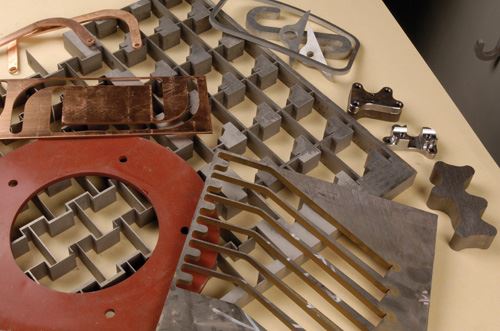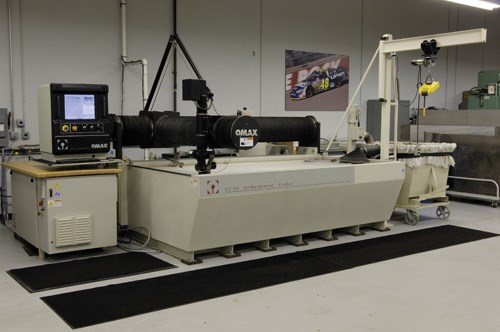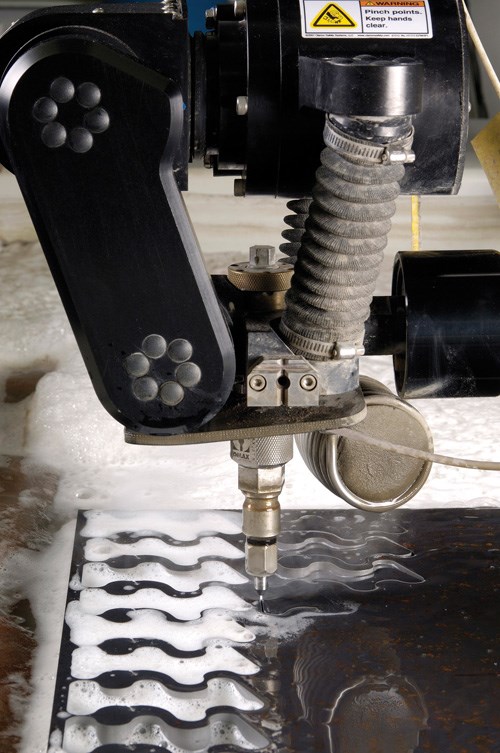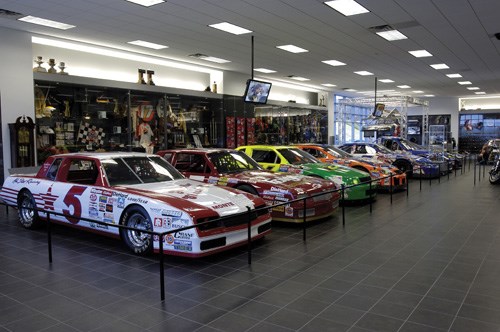Waterjet Drives Engineering Innovation
In NASCAR, machinists and engineers who work behind the scenes are often just as important as skilled drivers. Omax’s 55100 JetMachining Center abrasive waterjet has helped one team maintain its competitive edge by improving flexibility and productivity.
Share





As a sport that pushes the envelope at 200-plus miles per hour, NASCAR is often viewed by fans as an ultimate test of man and machine. Seat-of-the-pants driving and masterful strategy, however, are not the only elements that distinguish the winners from the rest—the creativity and ingenuity of engineers and machinists behind the scenes can be just as important.
That ingenuity and creativity is a driving force behind the success of one team, Hendrick Motorsports, which maintains a commitment to investing in advanced technology. One recent equipment purchase, an abrasive waterjet machine from Omax, has not only improved the flexibility of the team’s manufacturing processes, but also created more opportunity for engineering innovation.
"We needed a fast, accurate cutting solution that could excel at short-run part production and rapid prototyping," says Larry Zentmeyer, production manager at Hendrick. "Omax JetMachining Centers not only met those rigorous expectations, but also offered the versatility to cut a variety of materials."
Founded in 1984 by Rick Hendrick as a five-man team operating in a 5,000-square-foot shop, All-Star Racing was rechristened Hendrick Motorsports after a successful season with driver Geoff Bodine. Since then, the Concord, North Carolina-based organization has racked up eight Sprint Cup Series championships, three Camping World Truck Series titles, one Nationwide crown and more than 200 victories in NASCAR’s top three divisions. It is also the only organization to win the Sprint Cup Series championship in four consecutive seasons, with Jeff Gordon and Terry Labonte bringing home titles from 1995 to 1998.
The machine shop supports Hendrick’s four Sprint Cup programs and engine department as well as the JR Motorsports Nationwide team. It produces more than 600 engines per year, many of which are leased to Stewart-Haas Racing and other General Motors teams. Parts are produced on a fleet of laser machines, Haas CNCs and, as of late 2007, Omax’s 55100 JetMachining Center.
The 55100 is one of three large-footprint abrasive waterjets in that line. Though designed to cut complex parts from flat stock ranging to 5 × 10 feet, the waterjet distinguishes itself from laser machining with the ability to easily cut a wide variety of materials, including aluminum, copper, rubber and carbon fiber, the manufacturer says. Additionally, the machine is equipped with Omax’s Tilt-A-Jet system, which automatically calculates and offsets the natural taper that results from typical waterjet cutting heads.
After installation, Omax provided onsite operator training to Hendrick machinists Ricky Blackwelder and Scott McMillion as well as a handful of CNC operators. The crew trained by cutting real parts rather than the templates provided in the training software package. "The system is so intuitive that after 2 days, Ricky and Scott were able to hit the ground running," Mr. Zentmeyer says. "That was a huge advantage as we raced to manufacture parts in time for the Daytona 500 and the 2008 season."
Productivity improvements provided by the waterjet are exemplified in the manufacture of a rocker stand, an 8620 alloy steel part that holds the rocker arm in place on the engine. Reducing cycle time and increasing operator flexibility were especially important for this job, as a pair of rocker stands accompanies each engine.
Previously, the shop bought just enough material to complete an order. CNC operators then devoted countless hours to machining square pieces into sophisticated parts. Now, the shop buys sheet material in bulk and nests the parts to get the most out of each sheet. The waterjet cuts a blank in 15 minutes, and the rocker stand is finished on a CNC machine shortly after.
All in all, the machine has reduced cycle time on this job by approximately 15 to 20 percent, the company says. Additionally, finishing these parts requires so little maintenance that CNC operators can work on two or more machines at once. This was particularly beneficial in the run-up to the 2009 Sprint Cup season, when the machine cut blanks for 1,400 rocker stands in 6 weeks.
While that may seem like enough to keep the team well-stocked throughout the season, Mr. Zentmeyer notes that the nature of the sport requires improving parts from race to race. The parts the team takes to Daytona in February, for example, are typically not as good as the parts it takes to Talladega in April. However, while Hendrick puts considerable effort into improving existing pieces for the next race, the team works just as hard to design, test and implement new parts. "Waterjet technology helps us keep pace with those continuous developments," Mr. Zentmeyer says.
Word of the shop’s improved capabilities swept across the 100-acre campus as engineers realized that if they could design a part, the machine shop could likely cut it. Soon, the shop was inundated with orders for new parts, modified existing parts and even projects that were previously handled by third-party vendors. An important facilitator of the sudden influx in orders was the waterjet’s Intelli-Max software, which enables machinists to import .DXF design files and move parts to production in a matter of minutes. "It wasn’t long before e-mails were coming in with .DXF files attached and the machine was in operation 15 hours per day, 6 days per week," Mr. Zentmeyer says.
In fact, operators sometimes find that customers don’t fully understand the waterjet’s capabilities. For example, in one instance, Mr. Zentmeyer noticed a request for a piece with unusually small holes and followed the finished product back to the customer. He found that its machinists were performing unnecessary secondary operations. Hendrick had been using the waterjet only to pierce start holes, which the customer would then drill and tap. Testing revealed that the waterjet could hold tolerances to ±0.001 inch, enabling the shop to save both time and money by machining the holes directly to tap size.
The machine now produces thousands of parts per year, ranging from templates and brackets to carbon fiber seats and silicon rubber gaskets. "We knew the waterjet would provide more flexibility and versatility to ensure quick turnaround and improved productivity, but we never guessed how much it would enhance our engineering and manufacturing processes," Mr. Zentmeyer concludes.
Related Content
Inside the Premium Machine Shop Making Fasteners
AMPG can’t help but take risks — its management doesn’t know how to run machines. But these risks have enabled it to become a runaway success in its market.
Read MoreHow to Mitigate Chatter to Boost Machining Rates
There are usually better solutions to chatter than just reducing the feed rate. Through vibration analysis, the chatter problem can be solved, enabling much higher metal removal rates, better quality and longer tool life.
Read MoreHow to Successfully Adopt Five-Axis Machining
While there are many changes to adopt when moving to five-axis, they all compliment the overall goal of better parts through less operations.
Read MoreBallbar Testing Benefits Low-Volume Manufacturing
Thanks to ballbar testing with a Renishaw QC20-W, the Autodesk Technology Centers now have more confidence in their machine tools.
Read MoreRead Next
Registration Now Open for the Precision Machining Technology Show (PMTS) 2025
The precision machining industry’s premier event returns to Cleveland, OH, April 1-3.
Read More5 Rules of Thumb for Buying CNC Machine Tools
Use these tips to carefully plan your machine tool purchases and to avoid regretting your decision later.
Read MoreBuilding Out a Foundation for Student Machinists
Autodesk and Haas have teamed up to produce an introductory course for students that covers the basics of CAD, CAM and CNC while providing them with a portfolio part.
Read More



























.jpg;maxWidth=300;quality=90)













